Thermolysis and the Blend
Until the 1920s, the only way that superfluous hair could be permanently removed from the body safely was by electrolysis. It was slow, often painful, and very expensive so most women resorted to temporary hair-removal measures such as shaving or depilatories.
See also: Hair Removers and Electrolysis
In 1924, Dr. Henry Bordier [1863-1942] of Lyon, France suggested using short-wave diathermy to remove hair. As announced in the journal ‘Vie médicale’ and reported elsewhere, Bordier thought this new procedure was faster and less painful than conventional electrolysis.
Nouveau traitement de l’hypertrichose par la diathermie.
La diatherme présente les avantages suivants; c’est une méthode relativement rapide car la diathermo-coagulation de la papille est presque instantanée; elle ne laisse aucune trace ni cutanée ni sous-cutanée, elle est enfin beaucoup moins douloureuse que l’électrolyse.Translation:
New treatment of hypertrichosis by diathermy.
Diathermy has the following advantages; it is a relatively fast method because diathermo-coagulation of the papilla is almost instantaneous; it leaves no trace either cutaneously or subcutaneously, and finally it is much less painful than electrolysis.(Bulletin général de thérapeutique, 1924, p. 235)
See also: Diathermy
Despite the apparent advantages of the new technique, there were a number of technical problems which limited its adoption and it would be many years before short-wave diathermy machines producing high-frequency electrical current would be widely used in Beauty Culture to remove superfluous hair.
Early machines
Until the 1930s, high-frequency electrical currents were generated by machines that used one or more ‘spark-gaps’ to produce the high-frequency electrical oscillations. Unfortunately, the spark-gap was easily influenced by environmental factors like humidity and was difficult to control. Although operators could adjust the gap, they had to rely on the sound of the hissing spark to judge the intensity of the current which was less than satisfactory (Hinkel & Lind, 1968, p. 174).
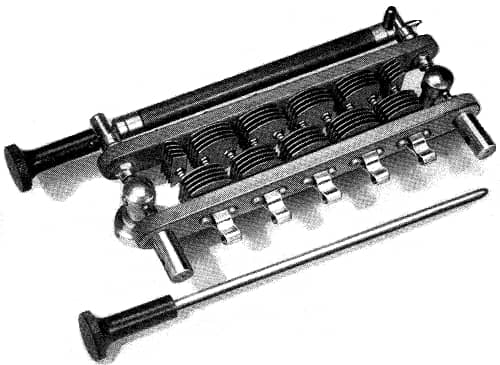
Above: A typical multiple spark-gap as used in a large cabinet high frequency machine in the 1930s.
Short-wave diathermy machines were used to gently warm parts of the body in ‘medical diathermy’ treatments but they could also generate the higher temperatures used in ‘surgical diathermy’ – to excise warts, carbuncles, malignant growths, tonsils and other things – by electrodessication (cautery) or by electrocoagulation. Some doctors also them to treat women suffering from hypertrichosis – abnormal or excessive hair growth – by destroying the papilla of the hair follicle with a high-frequency current as Bordier had suggested.
However, these diathermy machines were not generally embraced by Beauty Culture. As well as being more difficult to use, most manufacturers selling machines into the beauty industry remained with electrolysis. This does not mean they were totally ignored. In France, their use in Beauty Culture got a boost from the 1929 publication of the ‘Manuel d‘Épilation Définitive et sans Cicatrices par électrolyse et Diathermo-Coagulation’ by Dr. Simon-Alban Peytoureau and some salons did use them to remove superfluous hair and other skin blemishes. Helena Rubinstein, for example, had at least one short-wave diathermy machine operating in her London salon in 1929.
For some time now there have been interesting articles in the press about the marvellous possibilities of Diathermy—an electric current converted into heat which, on the Continent, has largely superseded the use of electrolysis. It is looked on as the herald of non-operative surgery, and, in this country, has been largely successfully used for the removal of tonsils. But, as far as I know, Madame Rubinstein is the only beauty specialist in this country to utilise it for the removal of superfluous hair, moles, warts, birthmarks etc. I was particularly interested in the fact that by this means she undertakes entirely to cure the unsightly little broken veins which are so often the result of exposure to sun and wind, to which our climate and our sports subject us.
The diathermic ray destroys the capillary so that the vein cannot reappear. Its action is much more rapid than that of the electric needle (it takes two or three seconds instead of sixty or more), and there is no pain and no danger whatever of permanent scarring.(Chrysis, 1929, p. 116)
Vacuum tubes
During the 1930s, despite some controversy over which was better, vacuum tubes began to replace spark-gaps and manufacturers began to produce and sell these new vacuum-tube, high-frequency machines to electrologists.

Above: An oscillator vacuum tube from the 1930s.
By 1940, many electrologists had moved from electrolysis to high frequency, because it was faster – even when compared to multiple needle electrolysis – enabling more hairs to be removed in a given time.
Diathermy treatment is similar to electrolysis in that a needle is inserted into the follicle and permanent hair removal is effected by the destruction of the papilla. This diathermic method is rapidly becoming popular in France and Germany. The advantages that are listed in its favor are: there are no electrodes; the operation is less painful; the process is faster in spite of the fact that only one needle is used; the irritation is slight.
(McDonough, 1937, p. 191)
Early on, hair-removal treatments using high frequency were often referred to as Short Wave, Radio Wave or Ray Treatments. This is not as strange as it sounds. Short-wave, high-frequency waves are in the same part of the electromagnetic spectrum as radio waves and can interfere with them. This was aptly demonstrated during the Second World War when British medical diathermy machines were deployed for a time in the ‘Battle of the Beams’ to try and block the radio signals the Germans were using to guide their bomber planes to their targets.
Today, high-frequency treatments can be advertised as thermolysis, diathermy or electrolysis. The last name is misleading and should only be applied to hair-removal techniques that use direct (galvanic) current to destroy the hair papilla through the production of lye (sodium hydroxide), not heat.
The Blend
The development of this technique was a combined effort between Henri E. St. Pierre, the director of The Dermic Laboratories in California, and Arthur Hinkel, a service engineer for the General Electric X-Ray Corporation. The Dermic Laboratories used X-ray machines to remove superfluous hair and this is probably how the two men met.
As the use of X-rays to remove superfluous hair came under increasing attack from the American Medical Association (AMA) and local authorities, it would appear that St. Pierre tried high-frequency machines but was dissatisfied with the results, particularly from the amount of regrowth he was getting. He wondered if was possible to combine the efficiency of electrolysis with the speed of high frequency and talked to Arthur Hinkel about designing and developing a suitable machine.
Beginning in 1930, Hinkel began experimenting with combining direct and alternating currents in the one device. A way of successfully blending the two currents was eventually developed and a patent application for an Electronic Epilator was submitted by Henri St. Pierre in 1945 and granted in 1948 (U.S. patent No. 2,444,173).
Even though a machine had been built, it took many years of trial and error before St. Pierre developed a satisfactory working method for removing hair with a combined current, and Arthur Hinkel rightly considers Henri the inventor of the Blend Method. In 1947, Hinkel became a licensed electrologist and together with St. Pierre they set up the St. Pierre Epilator Company in California in 1949. Hinkel also established the A. R. Hinkel Company in 1948. Unfortunately, I have been unable to determine the relationship between the two companies or who made the St. Pierre Electronic Epilator. Hinkel also established the Wilshire School of Electrology in Los Angeles, and another in Orange County, to train students in the Blend technique.
Initially, Blend machines were only sold to electrologists that were trained in the Blend Method and this slowed its spread from California to the rest of the world. Hinkel appears to have done most of the early promotion of the Blend. St Pierre may have kept a lower profile due to his previous involvement with the disastrous use of X-rays.
Action
The ‘dual action’ or ‘blend’ machine enabled an electrologist to use thermolysis and electrolysis on a hair follicle at the same time, destroying it by the combined action of heat and lye. However, as the combination of the two currents could be varied in a multitude of ways, training was required if the technique was to be used to best effect.
Since each of the two actions of the current can be independently controlled by the operator there are obviously many different intensity combinations to which the epilator can be adjusted. It therefore takes skill to operate the blend. … No two cases are alike, we have seen.
… [T]he key to successful use of the blend resides in maintaining just the right relationship between the two currents. If, on the one hand, the galvanic current is relied on two heavily, the advantage of high frequency’s speed is lost. On the other hand, if the high frequency’s action is stressed, a greater-than-necessary regrowth will result. Thus, if the relationship between the two currents is not properly proportioned, the technic [sic.] will swing to either electrolysis or high frequency, creating the inherent disadvantages of either of these separate methods. For this reason the developers of the blend equipment have, in the past, sold epilators only to those who were instructed in its proper use.(Hinkel & Lind, 1968, p. 202)
As well as the Blend, these machines allowed an electrologist to treat hairs with thermolysis or electrolysis as well and manufacturers provided operators with suggestions for varying the use of the different electrical currents depending on the client. The Sterex Company, for example, suggested using one of four techniques, known as the ‘Higher for Shorter Technique’, the ‘Lower for Longer Technique’, the ‘Treat and Leave Technique’ and ‘Galvanic Only’ with the ‘Higher for Shorter Technique’ being preferred as it was quicker. The selection of a technique was based primarily on a client’s reaction to pain but could also be varied depending on a range of factors including the morphology of the hair follicle.
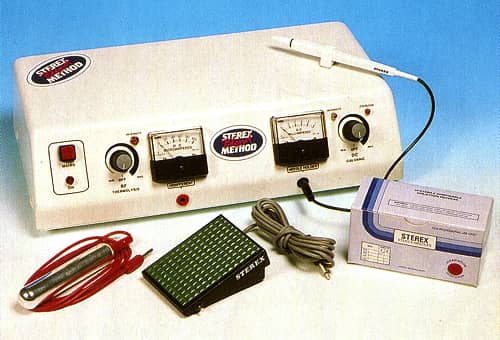
Above: Sterex Blend Method Machine.
Flash Method
Early thermolysis/diathermy machines were operated by a foot switch. Speaking very generally, the current was set to a moderate intensity and then applied for a number of seconds to allow a heating pattern to build and spread.
When transistors replaced vacuum tubes, timing devices were developed that could produce extremely short bursts of electrical current; much shorter than was possible manually. This resulted in the introduction of what has come to be called the ‘Flash Method’ which used bursts of high-intensity current for a fraction of a second. At first sight the flash method seems to have the potential of speeding up the permanent removal of hair and reducing pain. However, these ideas should be treated with some caution as the heating pattern of a flash burst is less extensive than that produced by manual thermolysis.

Above: Comparison of heating patterns in flash and manually controlled thermolysis/diathermy (Hinkel & Lind, 1968).
The reduced heating area could mean that germinative tissue is missed – particularly if the follicle is distorted – requiring additional treatments and further discomfort.

Above: Heating patterns in two curved hair follicles using flash (Hinkel & Lind, 1968).
The bulge
In 1990, it was suggested that the bulge region of the hair follicle – a region near the insertion site of the arrector pili muscle – contained stem cells that were capable of regenerating a hair follicle. If follicular epithelial stem cells reside in the bulge, and could give rise to all the components of the hair shaft, then any technique that concentrates solely on removing the dermal papilla at the base of the follicle may not result in its permanent destruction.

Above: Cross-section of a hair follicle showing the bulge region.
The best treatment
Any detailed examination of electrology practice will reveal that there is no general agreement on which method – electrolysis, thermolysis (manual and flash) or the blend – is best, and there is unlikely to be any resolution of this question in the near future. Differences in skin and hair types, reaction to pain and the skill of the practitioner, can make a method that is fine for one person a problem for another. For anyone thinking about undergoing a treatment my only suggestion would be to do a good deal of research and go slow; rushing into something can result in a lifetime of trouble and regret.
See also: High Frequency
First Posted: 16th June 2014
Last Update: 3rd April 2022
Sources
Chrysis. (1929). The complexion volte face and a new element in beauty culture. Britannia. 1(6), October, 116.
Doin, G. (Ed.). (1924). Bulletin général de thérapeutique. Paris.
Cartwright, E., Morris, G., & Severn, M. (2001). Electro-epilation: A practical approach. Cheltenham, UK: Nelson Thomas Ltd.
Cumberbatch, E. P. (1937). Diathermy including diathermotherapy and other forms of medical and surgical electrothermic treatment (3rd ed.). Great Britain: William Heinemann (Medical Books) Ltd.
Eberhart, N. M. (1911). A working manual of high frequency currents. Chicago: New Medicine Publishing Company.
Godfrey, S. (1992). The principles and practice of electrical epilation (3rd ed.). Oxford: Butterworth-Heinemann.
Hinkel, A. R., & Lind, R. W. (1968). Electrolysis, thermolysis and the blend: The principles and practice of permanent hair removal. Los Angeles, CA: Arroway.
Mahler, H. C. (1992). Epilator routes: 70 years of progress. A brief photo history. International Hair route. August, 16-20.
McDonough, E. G. (1937). Truth about cosmetics. New York, Drug and Cosmetic Company.

Early diathermy machine using a spark-gap to generate a high frequency current.
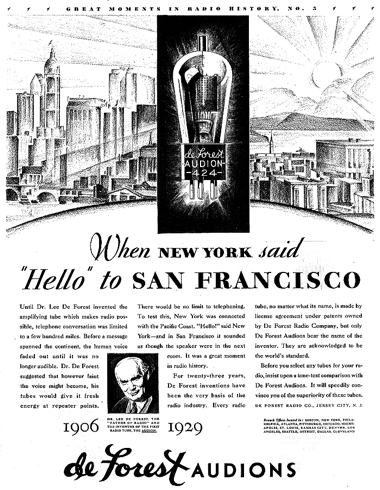
1929 Celebration of the development of the Audion vacuum tube developed by Lee de Forest [1873-1961] in 1906. Its technological descendants would not find their way into high frequency machines used for hair removal until the 1930s.

1934 Using thermolysis to remove forearm hair.
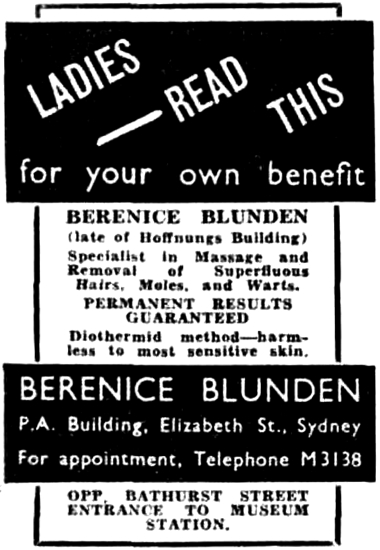
1939 Berenice Blunden advertising the removal of superfluous hairs, moles and warts using the ‘Diothermid Method’.
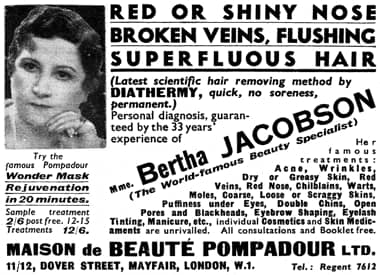
1939 Maison de Beauté Pompadour Ltd. diathermy hair removal.
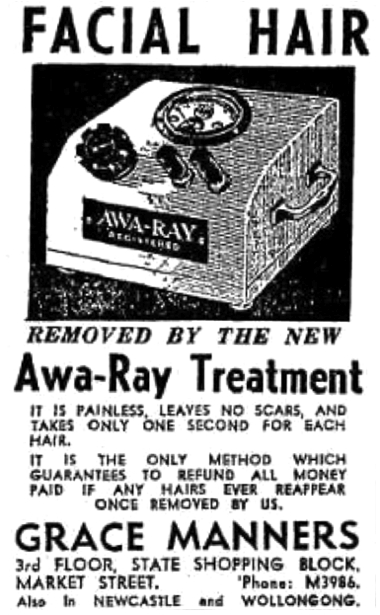
1940 Grace Manners AWA-Ray Treatment.
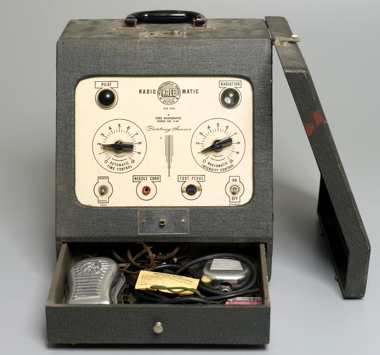
A Kree Radio-Matic high frequency machine with foot switch and electrodes in a draw.
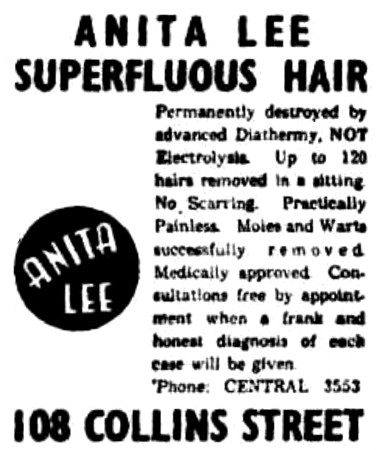
1945 Anita Lee. Hair permanently removed by diathermy not electrolysis.
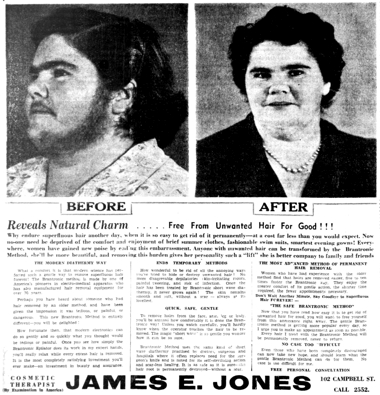
1950 James E. Jones. Diathermy permanent hair removal treatment the Brantronic way.

Henri Eugene St. Pierre [1891-1974], the inventor of the Blend technique. He used X-rays to remove hair until 1940 at least.
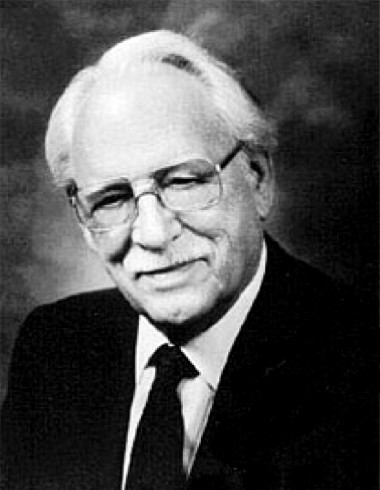
Arthur Hinkel [1916-1993] who developed the original Blend machine.
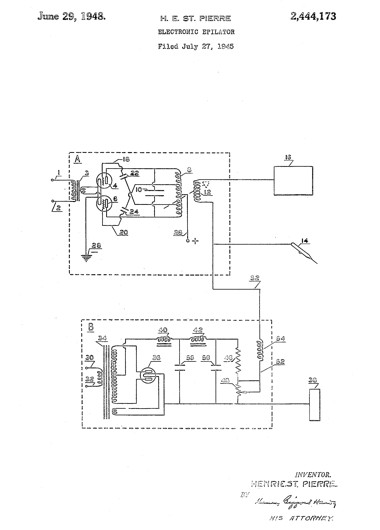
1948 Circuit drawing from U.S. patent No. 2,444,173 granted to Henri E. St. Pierre.
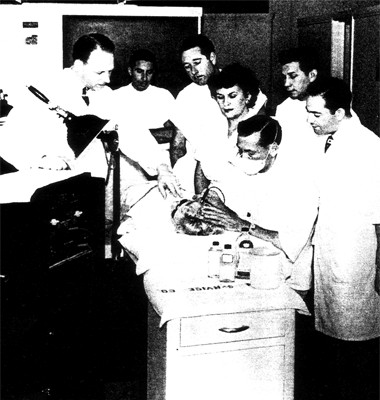
1948 Arthur Hinkel (left) instructing Marinello students in Los Angeles in the use of the Blend technique to permanently remove hair. The large machine is a St. Pierre Electronic Epilator. It was fashioned out of cold-rolled steel and cost US$1000 (Mahler, 1992, p. 20).
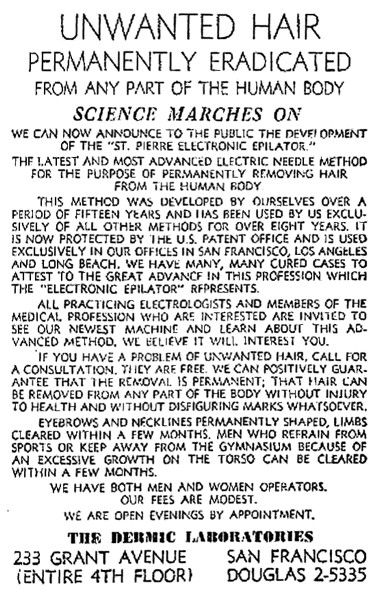
1948 The Dermic Laboratories advertising the St. Pierre Electronic Epilator. The advertisement states that they had been using the Blend technique for over eight years which suggests that Arthur Hinkel had an operational device by 1940 at the latest.
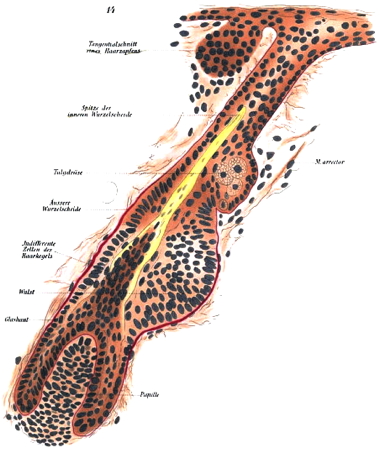
1903 The bulge (wulst or swelling) as described by the German histologist, Dr. Philipp Stöhr [1849-1911].
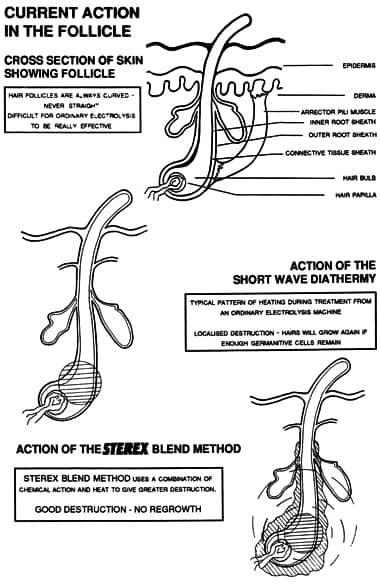
Part of a Sterex brochure describing the benefits of the Blend technique.
